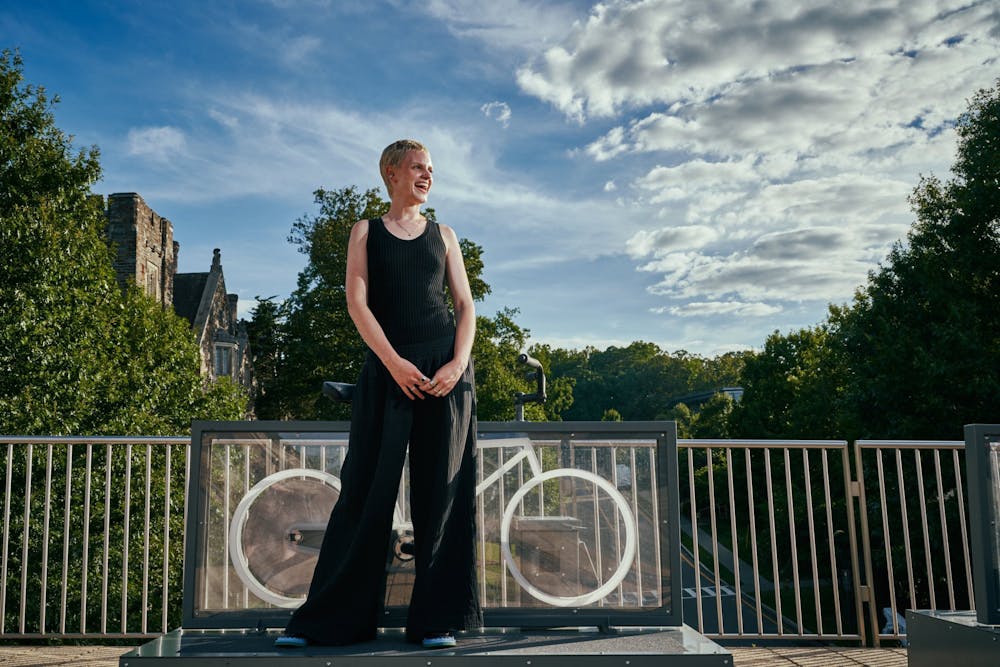Last month, our campus was graced by a temporary new addition: light-up bikes. Placed alongside the BC Plaza Bridge and at the entrance to the Ruby, at first glance they seem like weird, stationary bikes. But hop on them and you’re in for a novel experience that merges play with sustainability.
The story behind these bikes traces back to a conversation last spring. LeMonde Studio, a Quebec, Texas and New York-based art firm, reached out to DukeArts to propose the project, following their successful collaboration on a set of interactive, arts-themed music boxes. DukeArts loved the idea, according to Aaron Shackelford, the DukeArts Director of Programming, and they began working to make it reality. In collaboration with local publication LetsTalkDurham, they were able to identify six Durham artists to contribute to the project and provided some work of their own.
These bikes light up when ridden by students, presenting curated images and music. DukeArts hosted a total of nine bikes, placed in groups of three at BC Plaza, the Rubenstein Arts Center and Five Points. The three sections focus on themes of climate change, celebrating art, and celebrating Durham, respectively. On BC Plaza, students are treated to pieces by CJ Monet, Alivia Moe, Sarah Rain Hammond and Bill Fick that challenge the viewer to pay more attention to their environment and live a slower life. Outside the Ruby are pieces by Megan Easterling and Sunny Bad that reflect Durham’s Black community and create a generally celebratory atmosphere. At Five Points, pieces by Michael Garcia, Jim Lee and Sarah Rain Hammond that recognize Durham legend Baba Chuck, a dancer and choreographer focusing on African dance, and advocate for a wider conception of art.
The bike exhibit, called LightLane, traces back to a project they did in collaboration with the National Gallery of Singapore for their lights festival. While the bikes received a glowing reception by the public, logistical problems unfortunately led to the bikes being stashed in a warehouse, where they degraded due to humidity. Undeterred, LeMonde rebuilt the bikes and launched the project in America. To date, these bikes have been featured in cities like New York, Milwaukee, and Tempe, Arizona; the Duke installation ran parallel to yet another installation based in Seattle.
The project itself marries two of LeMonde Studio’s passions: art you can engage with and sustainability. Nicolas Synnot, LeMonde’s Chief Operating Officer and Managing Partner, connected the bikes project to his belief in art as something that can be happened upon, not just sought out. This was the inspiration behind making the bikes require human interaction to produce the art. He also talked about how he sees sustainability as granting artists a new opportunity to engage in the public discourse and discussion. However, he thinks that this sustainability should be something that creates additional benefits in a project rather than just messaging.
Overall, I greatly enjoyed the bikes and felt they had the desired effect. On my regular walks around campus, I’d see kids try them out and be genuinely surprised by the music. On a campus that often requires students to actively seek out its phenomenal art and artists, it was refreshing to see a project that students could just happen across and be surprised by. I hope to see more projects like this from DukeArts going forward. Synnot echoed my sentiment, saying that he’d love to do more interactive projects on campus going forward, potentially bringing in the Engineering department.
While the bikes have since left our campus, I hope they can inspire at least a few members of our community to seek out more opportunities to engage with the arts on campus. I promise you, it’s worth it.
Get The Chronicle straight to your inbox
Sign up for our weekly newsletter. Cancel at any time.
Zev van Zanten is a Trinity junior and recess editor of The Chronicle's 120th volume.

